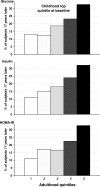Utility of childhood glucose homeostasis variables in predicting adult diabetes and related cardiometabolic risk factors: the Bogalusa Heart Study
- PMID: 20009096
- PMCID: PMC2827529
- DOI: 10.2337/dc09-1635
Utility of childhood glucose homeostasis variables in predicting adult diabetes and related cardiometabolic risk factors: the Bogalusa Heart Study
Abstract
OBJECTIVE This study examines the usefulness of childhood glucose homeostasis variables (glucose, insulin, and insulin resistance index [homeostasis model assessment of insulin resistance {HOMA-IR}]) in predicting pre-diabetes and type 2 diabetes and related cardiometabolic risk factors in adulthood. RESEARCH DESIGN AND METHODS This retrospective cohort study consisted of normoglycemic (n = 1,058), pre-diabetic (n = 37), and type 2 diabetic (n = 25) adults aged 19-39 years who were followed on average for 17 years since childhood. RESULTS At least 50% of the individuals who ranked highest (top quintile) in childhood for glucose homeostasis variables maintained their high rank by being above the 60th percentile in adulthood. In a multivariate model, the best predictors of adulthood glucose homeostasis variables were the change in BMI Z score from childhood to adulthood and childhood BMI Z score, followed by the corresponding childhood levels of glucose, insulin, and HOMA-IR. Further, children in the top decile versus the rest for insulin and HOMA-IR were 2.85 and 2.55 times, respectively, more likely to develop pre-diabetes; children in the top decile versus the rest for glucose, insulin, and HOMA-IR were 3.28, 5.54, and 5.84 times, respectively, more likely to develop diabetes, independent of change in BMI Z score, baseline BMI Z score, and total-to-HDL cholesterol ratio. In addition, children with adverse levels (top quintile versus the rest) of glucose homeostasis variables displayed significantly higher prevalences of, among others, hyperglycemia, hypertriglyceridemia, and metabolic syndrome. CONCLUSIONS Adverse levels of glucose homeostasis variables in childhood not only persist into adulthood but also predict adult pre-diabetes and type 2 diabetes and relate to cardiometabolic risk factors.
Figures

Comment in
-
Utility of childhood glucose homeostasis variables in predicting adult diabetes and related cardiometabolic risk factors: the Bogalusa Heart Study: comment on Nguyen et Al.Diabetes Care. 2010 Sep;33(9):e123; author reply e124. doi: 10.2337/dc10-0827. Diabetes Care. 2010. PMID: 20805265 Free PMC article. No abstract available.
References
-
- Hoyert DL, Heron MP, Murphy SL, Kung H: Deaths: Final Data for 2003: National Vital Statistics Reports. Vol. 54, No. 13. Hyattsville, MD, National Center for Health Statistics, 2006. - PubMed
-
- Cowie CC, Rust KF, Byrd-Holt DD, Eberhardt MS, Flegal KM, Engelgau MM, Saydah SH, Williams DE, Geiss LS, Gregg EW: Prevalence of diabetes and impaired fasting glucose in adults in the U.S. population: National Health And Nutrition Examination Survey 1999–2002. Diabetes Care 2006;29:1263–1268 - PubMed
-
- Fox CS, Sullivan L, D'Agostino RB, Sr, Wilson PW: the Framingham Heart Study. The significant effect of diabetes duration on coronary heart disease mortality: the Framingham Heart Study. Diabetes Care 2004;27:704–708 - PubMed
-
- Abdul-Ghani MA, Tripathy D, DeFronzo RA: Contributions of β-cell dysfunction and insulin resistance to the pathogenesis of impaired glucose tolerance and impaired fasting glucose. Diabetes Care 2006;29:1130–1139 - PubMed
-
- Reaven GM: Banting Lecture 1988: role of insulin resistance in human disease Diabetes 1988;37:1595–607 - PubMed

